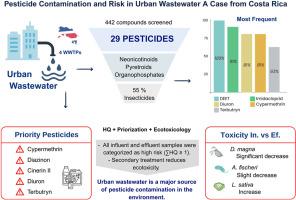Occurrence and environmental risk assessment of pesticides in urban wastewater in Costa Rica
IF 7.3
2区 环境科学与生态学
Q1 ENVIRONMENTAL SCIENCES
引用次数: 0
Abstract
Environmental contamination with pesticides from agricultural applications in rural areas has been widely studied, however, in urban areas, wastewater represents one of the main pathways for pesticide contamination. This issue has received little attention, particularly in developing countries, where permissive legislation often prevails. This study aimed to quantify pesticide active ingredients in urban wastewater from medium-to large-scale wastewater treatment plants (WWTPs) in Costa Rica using a broad detection protocol (442 compounds) and to estimate environmental risk through hazard quotient (HQ) calculations, ecotoxicological assays and a prioritization approach to generate a local list of high-priority pesticides. In total, 29 pesticides were detected, mainly insecticides (55%), dominated by neonicotinoids, pyrethroids and organophosphates. The most frequently detected compounds were diethyltoluamide (100% of samples), imidacloprid (91%), diuron (81%), cypermethrin (81%) and terbutryn (63%). Considering HQ values, 17 compounds exhibited high environmental risk, the most hazardous being deltamethrin (HQ=93750), diazinon (HQ=6000), cinerin II (HQ=1857), cyfluthrin (HQ=743) and cypermethrin (HQ=549). All influent and effluent samples were categorized as high risk (∑HQ ≥ 1). However, WWTPs with secondary treatment had a lower calculated ecotoxicological hazard in effluents. The prioritization criterion identified cypermethrin, diazinon, cinerin II, diuron and terbutryn as the top prime-concern pesticides (level of ecotoxicological risk = 3.6, 2.8, 2.7, 2.6 and 2.6 respectively). Ecotoxicological analyses revealed that Aliivibrio fischeri was the most vulnerable model organism, followed by Daphnia magna and Lactuca sativa. A significant decrease in the ecotoxicity to D. magna was observed when comparing influents to effluents, whereas A. fischeri exhibited only a slight decrease. Conversely, for L. sativa, some effluents showed higher toxicity. For specific WWTPs, ecotoxicity correlated well with organic matter content (R2 0.581-0.936). These findings provide critical data for regulatory authorities, identifying priority compounds from an ecotoxicological perspective, offering a case study for pesticide risk in urban wastewater in developing nations.

哥斯达黎加城市污水中农药的发生及环境风险评价
农村地区农业应用中农药对环境的污染已经得到了广泛的研究,然而在城市地区,废水是农药污染的主要途径之一。这个问题很少受到注意,特别是在发展中国家,那里往往实行宽松的立法。本研究旨在使用广泛的检测方案(442种化合物)量化哥斯达黎加中大型污水处理厂(WWTPs)城市废水中的农药活性成分,并通过危害商数(HQ)计算、生态毒理学分析和优先排序方法来估计环境风险,从而生成当地高优先级农药清单。共检出农药29种,以杀虫剂为主(55%),以新烟碱类、拟除虫菊酯类和有机磷类为主。检出频率最高的化合物为二乙基甲苯酰胺(100%)、吡虫啉(91%)、迪乌伦(81%)、氯氰菊酯(81%)和特非特灵(63%)。从HQ值来看,17种化合物具有较高的环境风险,其中最危险的是溴氰菊酯(HQ=93750)、二嗪菊酯(HQ=6000)、cininerin II (HQ=1857)、氟氯菊酯(HQ=743)和氯氰菊酯(HQ=549)。所有进水和出水样本均为高风险(∑HQ≥1)。然而,经过二级处理的污水处理厂在流出物中具有较低的计算生态毒理学危害。生态毒理学风险等级分别为3.6、2.8、2.7、2.6、2.6,优先级标准确定氯氰菊酯、二嗪菊酯、二氰菊酯、特虫脒为最优先关注农药。生态毒理学分析显示,最脆弱的模式生物为费氏alivibrio fischeri,其次为大水蚤(Daphnia magna)和乳酸(Lactuca sativa)。当比较进水和出水时,观察到对D. magna的生态毒性显著降低,而A. fischeri仅表现出轻微的降低。相反,对于L. sativa,一些出水表现出更高的毒性。对于特定的污水处理剂,生态毒性与有机质含量呈显著相关(R2 0.581-0.936)。这些发现为监管当局提供了关键数据,从生态毒理学角度确定了优先化合物,为发展中国家城市废水中的农药风险提供了一个案例研究。
本文章由计算机程序翻译,如有差异,请以英文原文为准。
求助全文
约1分钟内获得全文
求助全文
来源期刊

Environmental Pollution
环境科学-环境科学
CiteScore
16.00
自引率
6.70%
发文量
2082
审稿时长
2.9 months
期刊介绍:
Environmental Pollution is an international peer-reviewed journal that publishes high-quality research papers and review articles covering all aspects of environmental pollution and its impacts on ecosystems and human health.
Subject areas include, but are not limited to:
• Sources and occurrences of pollutants that are clearly defined and measured in environmental compartments, food and food-related items, and human bodies;
• Interlinks between contaminant exposure and biological, ecological, and human health effects, including those of climate change;
• Contaminants of emerging concerns (including but not limited to antibiotic resistant microorganisms or genes, microplastics/nanoplastics, electronic wastes, light, and noise) and/or their biological, ecological, or human health effects;
• Laboratory and field studies on the remediation/mitigation of environmental pollution via new techniques and with clear links to biological, ecological, or human health effects;
• Modeling of pollution processes, patterns, or trends that is of clear environmental and/or human health interest;
• New techniques that measure and examine environmental occurrences, transport, behavior, and effects of pollutants within the environment or the laboratory, provided that they can be clearly used to address problems within regional or global environmental compartments.
 求助内容:
求助内容: 应助结果提醒方式:
应助结果提醒方式:


